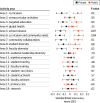Analysis of Social Mission Commitment at Dental, Medical, and Nursing Schools in the US
- PMID: 35532935
- PMCID: PMC9086841
- DOI: 10.1001/jamanetworkopen.2022.10900
Analysis of Social Mission Commitment at Dental, Medical, and Nursing Schools in the US
Abstract
Importance: The COVID-19 pandemic and calls for racial justice have highlighted the need for schools to promote social mission. Measuring social mission engagement and performance in health professions education may encourage institutional efforts to advance health equity and social justice commitments.
Objective: To describe the current state of social mission commitment within dental, medical, and nursing schools in the US and to examine how social mission performance compares across school types.
Design, setting, and participants: This cross-sectional survey study invited all US dental and medical schools and a subset of baccalaureate- and master's degree-conferring nursing schools to participate in a self-assessment to measure their school's social mission commitment from January 29 through October 9, 2019. The survey measured 79 indicators (with indicators defined as responses to specific scored questions that indicated the state or level of social mission commitment) across 18 areas in 6 domains of school functioning (educational program, community engagement, governance, diversity and inclusion, institutional culture and climate, and research) that have potential to enhance social mission engagement and performance. Individual health professions schools were the unit of analysis, and 689 dental, medical, and nursing schools were invited to participate. School deans and program directors were the primary target respondents because of their broad insight into their school's programs and policies and their ability to request data from various internal sources. Demographic information from respondents was not collected because multiple respondents from an institution could complete different sections of the survey.
Main outcomes and measures: Survey responses were analyzed to create indicator scores, standardized area scores, and an overall social mission score for each school. Using descriptive analyses, frequency and contingency tables of specific indicators within each area were created, and schools were compared based on ownership status (private or public), Carnegie Classification of Institutions of Higher Education research classification group (doctoral university with very high research activity [R1], doctoral university with high [R2] or moderate [R3] research activity, baccalaureate or master's nursing college or university, or special focus institution), and discipline group (dental school, medical school granting doctor of osteopathic medicine [DO] degrees, medical school granting doctor of medicine [MD] degrees, nursing school granting baccalaureate-level degrees, or nursing school granting master's-level degrees).
Results: Among 689 invited schools, 242 schools (35.1%) completed the self-assessment survey. Of those, 133 (55.0%) were nursing schools, 83 (34.3%) were medical schools, and 26 (10.7%) were dental schools. Response rates ranged from 133 of 420 invited nursing schools (31.7%) to 83 of 203 invited medical schools (40.9%). Most schools included social determinants of health in their curriculum in either required courses (233 of 242 schools [96.3%]) or elective courses (4 of 242 schools [1.7%]), but only 116 of 235 schools (49.4%) integrated social determinants of health across all years of study. Most schools also included health disparities in either their required courses (232 of 242 [95.9%]) or elective courses (6 of 242 [2.5%]); however, only 118 of 235 schools (50.2%) integrated health disparities across all years of study. In several areas of social mission, public schools performed better than private schools (eg, curriculum: mean [SE] standardized area score, 0.13 [0.07] points vs -0.14 [0.09] points, respectively), and R1 doctoral universities and special focus institutions performed better than R2 and R3 doctoral universities and baccalaureate and master's nursing colleges and universities (eg, extracurricular activities: mean [SE] standardized area score, 0.25 [0.09] points for R1 doctoral universities and 0.20 [0.12] points for special focus institutions vs -0.05 [0.12] points for R2 and R3 doctoral universities and - 0.30 [0.12] points for baccalaureate and master's nursing colleges and universities. Different areas of strength emerged for dental, medical, and nursing schools. For example, in the curriculum area, MD-granting medical schools had a mean (SE) standardized area score of 0.38 (0.08) points, which was significantly higher than the standardized area scores of dental schools (mean [SE], -0.21 [0.14] points), DO-granting medical schools (mean [SE], -0.22 [0.13] points), graduate nursing schools (mean [SE], -0.21 [0.19] points), and undergraduate nursing schools (mean [SE], -0.05 [0.10] points).
Conclusions and relevance: In this study, there was widespread interest from health professions educational leaders in understanding and enhancing social mission commitment. Future work may focus on identifying and promoting best practices using the framework described, providing schools with continued opportunities for self-assessment, and further validating the self-assessment survey.
Conflict of interest statement
Figures



Similar articles
-
Diversity in Mission Statements and Among Students at US Medical Schools Accredited Since 2000.JAMA Netw Open. 2023 Dec 1;6(12):e2346916. doi: 10.1001/jamanetworkopen.2023.46916. JAMA Netw Open. 2023. PMID: 38095898 Free PMC article.
-
Social Mission Metrics: Developing a Survey to Guide Health Professions Schools.Acad Med. 2020 Dec;95(12):1811-1816. doi: 10.1097/ACM.0000000000003324. Acad Med. 2020. PMID: 32217852 Free PMC article.
-
Perceptions of Dental Hygiene Master's Degree Learners About Dental Hygiene Doctoral Education.J Dent Hyg. 2015 Aug;89(4):210-8. J Dent Hyg. 2015. PMID: 26304945
-
The journey toward geriatric excellence in a non-research-intensive university.J Prof Nurs. 2006 Mar-Apr;22(2):84-90. doi: 10.1016/j.profnurs.2006.01.011. J Prof Nurs. 2006. PMID: 16564472 Review.
-
New nursing education structure in Spain.Nurse Educ Today. 2009 Jul;29(5):500-4. doi: 10.1016/j.nedt.2008.11.008. Epub 2008 Dec 27. Nurse Educ Today. 2009. PMID: 19111942 Review.
Cited by
-
Setting the Target: Comparing Family Medicine Among US Allopathic Target Schools.Fam Med. 2024 May;56(5):280-285. doi: 10.22454/FamMed.2024.510377. Epub 2024 Mar 11. Fam Med. 2024. PMID: 38506699 Free PMC article.
-
A cross-sectional study of newly established medical schools in the United States: student body diversity remains an unmet challenge.Med Educ Online. 2025 Dec;30(1):2487660. doi: 10.1080/10872981.2025.2487660. Epub 2025 Apr 2. Med Educ Online. 2025. PMID: 40176252 Free PMC article.
References
-
- American Medical Association . Organizational strategic plan to embed racial justice and advance health equity, 2021-2023. 2021. Accessed July 6, 2021. https://www.ama-assn.org/system/files/2021-05/ama-equity-strategic-plan.pdf
Publication types
MeSH terms
LinkOut - more resources
Full Text Sources
Medical

